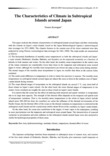The Characteristics of Climate in Subtropical Islands around Japan
JIRCAS international symposium series
| ISSN | 13406108 |
|---|---|
| 書誌レコードID(総合目録DB) | AA1100908X |

本文フルテキスト
intlsymp-13_25-32.pdf2.19 MB
This paper analyzes the climatic characteristics of subtropical islands around Japan and their relationship with the climate on Japan's main islands, based on the Japan Meteorological Agency's meteorological data (averages for 1971-2000). The climatic features in the eastern area of the Asian continent were also analyzed by using Chinese meteorological data (averages for 1961-1990). The main results are summarized as follows.
(1) The horizontal distribution of monthly mean temperatures in both the subtropical islands and Japan's main islands (Hokkaido, Honshu, Shikoku, and Kyushu) can be expressed accurately as a function of latitude in both summer and winter. On the other hand, the monthly mean temperatures in the eastern area of the Asian continent are considerably lower than those in the temperate and subtropical areas around Japan in winter, although the monthly mean temperatures are almost the same as these areas during summer. The annual ranges of the monthly mean temperatures in Japan are smaller than those in the eastern Asian continent.
(2) The north-south difference in temperature is wide in winter but narrower in summer. The monthly mean temperatures on subtropical islands around Japan are almost the same as those in the southern area of Japan's main islands during summer.
(3) The mean diurnal ranges of temperature on the subtropical islands are around 5 °C, only about half of those inland on Japan's main islands. On the other hand, the mean diurnal ranges of temperature in the eastern Asian continent are roughly the same as those inland on Japan's main islands.
It is known that the ocean has the effect of reducing both temporal and spatial variation in temperature due to its large heat capacity. The strength of this thermal effect depends on the temporal and spatial scale of temperature variations. That is, the monthly mean temperatures in the whole of Japan (which include inland areas 100-200 km from the coastline) are under the influence of the thermal environments of the Pacific Ocean, but the thermal effect of the ocean on the diurnal variations in temperatures is restricted in the subtropical small islands and the coastal areas (within about 50 km of the coastline) on Japan's main islands.
On the other hand, the ocean also contributes to the supply of water vapor to the atmosphere, resulting in more precipitation over the temperate and subtropical areas around Japan. The characteristics of seasonal variations in precipitation and solar radiation on the subtropical islands around Japan were also analyzed to clarify the hydrological properties of these areas.
(1) The horizontal distribution of monthly mean temperatures in both the subtropical islands and Japan's main islands (Hokkaido, Honshu, Shikoku, and Kyushu) can be expressed accurately as a function of latitude in both summer and winter. On the other hand, the monthly mean temperatures in the eastern area of the Asian continent are considerably lower than those in the temperate and subtropical areas around Japan in winter, although the monthly mean temperatures are almost the same as these areas during summer. The annual ranges of the monthly mean temperatures in Japan are smaller than those in the eastern Asian continent.
(2) The north-south difference in temperature is wide in winter but narrower in summer. The monthly mean temperatures on subtropical islands around Japan are almost the same as those in the southern area of Japan's main islands during summer.
(3) The mean diurnal ranges of temperature on the subtropical islands are around 5 °C, only about half of those inland on Japan's main islands. On the other hand, the mean diurnal ranges of temperature in the eastern Asian continent are roughly the same as those inland on Japan's main islands.
It is known that the ocean has the effect of reducing both temporal and spatial variation in temperature due to its large heat capacity. The strength of this thermal effect depends on the temporal and spatial scale of temperature variations. That is, the monthly mean temperatures in the whole of Japan (which include inland areas 100-200 km from the coastline) are under the influence of the thermal environments of the Pacific Ocean, but the thermal effect of the ocean on the diurnal variations in temperatures is restricted in the subtropical small islands and the coastal areas (within about 50 km of the coastline) on Japan's main islands.
On the other hand, the ocean also contributes to the supply of water vapor to the atmosphere, resulting in more precipitation over the temperate and subtropical areas around Japan. The characteristics of seasonal variations in precipitation and solar radiation on the subtropical islands around Japan were also analyzed to clarify the hydrological properties of these areas.
| 作成者 | Tsuneo Kuwagata |
|---|---|
| 著者キーワード | East Asia hydrometeorology maritime climate temperature thermal effect of ocean |
| 公開者 | Japan International Research Center for Agricultural Sciences |
| オンライン掲載日 | |
| 号 | 13 |
| 開始ページ | 25 |
| 終了ページ | 32 |
| 言語 | eng |
